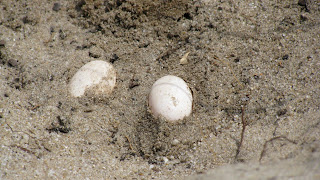
Diamond Back Terrapins (Malaclemys centrata) are small turtles that use both coastal waters and shore
lines. Living many decades, they measure about 13 cm long (about 10 inches), and
weigh about 500 grams. (just over 1 pound).
They are found almost exclusively on the Eastern US coast – between Massachusetts and Texas
We set out on Monday, June 28 to help Don Lewis (the Turtle Guy) his wife Susan Nourse and Bob Prescott, director of the Mass Audobon Sanctuary in Wellfleet in their effort to learn about and help these turtles.
Endangered, not only because their predators are healthy and plentiful, but also because the various habitats they use are decreasing in size and number. The terrapins (which means edible turtle) nest on beach dunes
and in hard packed sand and dirt in the areas around Wellfleet, MA. Both of these habitats see a lot of human traffic. The most common hard-packed sandy dirt areas are dirt roads and paths. Cars and people actually do more to keep predators away, than harm the eggs – as the turtles dig deep.
Beach dunes are patrolled late at night by foxes, raccoons and other critters that dig into the nests, eating the dozen or so eggs there.
To protect the nests, Don and team first need to find them – knowing the likely places that a nest will be built comes from experience – both of the turtle scientist and the turtle. Terrapins come back to nest where they were born. Don and Sue have a good sense of the preferred habitats for nests.
They dig to check for eggs


Then they cover the nest with a protective cage.
(This nest was actually disturbed – Don and Sue re-caged it). When the hatchlings emerge in about 55 days, someone is on hand to remove the cages and assure that the babies make it to the nearest water, where they will spend the next year or so.
Another clue is the many flipper marks the females leave in the sand – however – there may be many, MANY tracks that end up being as confusing as they are informative
The team goes out to the “Run” to catch them coming in to feed with the change of the tide. Walking from the Sanctuary Headquarters at low tide, the team heads to the water, nets in hand

Then we wade and watch…..
Lance’s first catch of the day!
Lance’s second catch of the day
Each turtle is examined and documented
The plastron (underside)

and carapace are measured

Each turtle caught is marked with notches in the carapace. Don has a chart with each of the “scutes” and marginals numbered. If there are no previous notches, the turtle is assigned the next number and notches are made (very carefully) with a file

All of the information is documented and entered into a computer data base
OF COURSE – each turtle is released back to the wilds to return to her mission of mating and reproducing many more Diamond Back Terrapins. Females live many decades, and continue to be productive throughout their lives. With a bit of care and help, these wonderful creatures can be brought back to healthy, sustainable numbers!








No comments:
Post a Comment